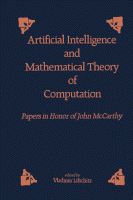Browse content
Table of contents
Actions for selected chapters
- Full text access
- Book chapterNo access
A Short Sketch of the Life and Career of John McCarthy
David J. Israel
Pages 1-5 - Book chapterNo access
Functional Instantiation in First-Order Logic
Robert S. Boyer, David M. Goldschlag, ... J. Strother Moore
Pages 7-26 - Book chapterNo access
Lambda: the Ultimate Combinator
Robert Cartwright
Pages 27-46 - Book chapterNo access
Proofs of Termination and the “91” Function
Solomon Feferman
Pages 47-63 - Book chapterNo access
Robots with Common Sense?
Jerome A. Feldman
Pages 65-72 - Book chapterNo access
Ascribing Artificial Intelligence to (Simpler) Machines, or When AI Meets the Real World
Robert E. Filman
Pages 73-89 - Book chapterNo access
The Design of Parallel Programming Languages
Richard P. Gabriel
Pages 91-108 - Book chapterNo access
Metaprogramming at Work in Automated Manufacturing
Chris Goad
Pages 109-128 - Book chapterNo access
LISP + Calculus = Identities
R.Wm. Gosper
Pages 129-149 - Book chapterNo access
Model Checking vs. Theorem Proving: A Manifesto
Joseph Y. Halpern and Moshe Y. Vardi
Pages 151-176 - Book chapterNo access
Algebraic Computation: The Quiet Revolution
Anthony C. Hearn
Pages 177-186 - Book chapterNo access
LISP and Parallelism
Takayasu Ito
Pages 187-206 - Book chapterNo access
Textbook Examples of Recursion
Donald E. Knuth
Pages 207-229 - Book chapterNo access
A Metalogic Programming Approach to Multi-Agent Knowledge and Belief
Robert Kowalski and Jin-Sang Kim
Pages 231-246 - Book chapterNo access
Belief and Introspection
Hector J. Levesque
Pages 247-260 - Book chapterNo access
Monotonicity Properties in Automated Deduction
Zohar Manna, Mark Stickel and Richard Waldinger
Pages 261-280 - Book chapterNo access
Circumscription and Disjunctive Logic Programming
Jack Minker, Jorge Lobo and Arcot Rajasekar
Pages 281-304 - Book chapterNo access
On the Equivalence of Data Representations
John C. Mitchell
Pages 305-329 - Book chapterNo access
Caution! Robot Vehicle!
Hans P. Moravec
Pages 331-343 - Book chapterNo access
Circumscription and Authority
Peter K. Rathmann and Gio Wiederhold
Pages 345-358 - Book chapterNo access
The Frame Problem in the Situation Calculus: A Simple Solution (Sometimes) and a Completeness Result for Goal Regression
Raymond Reiter
Pages 359-380 - Book chapterNo access
An Abstraction Mechanism for Symbolic Expressions
Masahiko Sato
Pages 381-391 - Book chapterNo access
Varieties of Context
Yoav Shoham
Pages 393-407 - Book chapterNo access
The Influence of the Designer on the Design—J. McCarthy and LISP
Herbert Stoyan
Pages 409-426 - Book chapterNo access
Binding Structures
Carolyn Talcott
Pages 427-448 - Book chapterNo access
Logicism, AI, and Common Sense: John McCarthy's Program in Philosophical Perspective
Richmond H. Thomason
Pages 449-466 - Book chapterNo access
The Incorrectness of the Bisection Algorithm
Richard Weyhrauch
Pages 467-468 - Book chapterNo access
Index
Pages 469-475
About the book
Description
Artificial and Mathematical Theory of Computation is a collection of papers that discusses the technical, historical, and philosophical problems related to artificial intelligence and the mathematical theory of computation. Papers cover the logical approach to artificial intelligence; knowledge representation and common sense reasoning; automated deduction; logic programming; nonmonotonic reasoning and circumscription. One paper suggests that the design of parallel programming languages will invariably become more sophisticated as human skill in programming and software developments improves to attain faster running programs. An example of metaprogramming to systems concerns the design and control of operations of factory devices, such as robots and numerically controlled machine tools. Metaprogramming involves two design aspects: that of the activity of a single device and that of the interaction with other devices. One paper cites the application of artificial intelligence pertaining to the project "proof checker for first-order logic" at the Stanford Artificial Intelligence Laboratory. Another paper explains why the bisection algorithm widely used in computer science does not work. This book can prove valuable to engineers and researchers of electrical, computer, and mechanical engineering, as well as, for computer programmers and designers of industrial processes.
Artificial and Mathematical Theory of Computation is a collection of papers that discusses the technical, historical, and philosophical problems related to artificial intelligence and the mathematical theory of computation. Papers cover the logical approach to artificial intelligence; knowledge representation and common sense reasoning; automated deduction; logic programming; nonmonotonic reasoning and circumscription. One paper suggests that the design of parallel programming languages will invariably become more sophisticated as human skill in programming and software developments improves to attain faster running programs. An example of metaprogramming to systems concerns the design and control of operations of factory devices, such as robots and numerically controlled machine tools. Metaprogramming involves two design aspects: that of the activity of a single device and that of the interaction with other devices. One paper cites the application of artificial intelligence pertaining to the project "proof checker for first-order logic" at the Stanford Artificial Intelligence Laboratory. Another paper explains why the bisection algorithm widely used in computer science does not work. This book can prove valuable to engineers and researchers of electrical, computer, and mechanical engineering, as well as, for computer programmers and designers of industrial processes.
Details
ISBN
978-0-12-450010-5
Language
English
Published
1991
Copyright
Copyright © 1991 Elsevier Inc. All rights reserved.
Imprint
Academic Press
